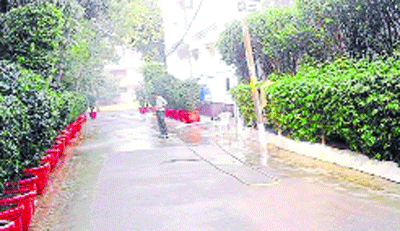There’s a huge gap in the tourism industry’s water use and the municipal corporation’s water supply, find SIDDHARTHA GAUTAM and SIRAJUDDIN AHMED
Rapid urbanisation and exponential growth of tourism have led to a rise in per capita water consumption, especially among the elite section of the society. As per a 2015 report by the World Bank, tourism growth in India for the period between 1995 and 2013 was at 200 per cent which is twice the world average of 100 per cent growth. India is moving towards a water crisis situation since our fresh water resources availability is limited, and the gap between the demand and supply of water is widening. It should be noted that India has 18 per cent of the world population and just four per cent of the water resources. Since 1947, annual per capita water availability of 6,043 cubic metres has been reduced to 1,545 cubic metres. This statistics clearly shows that India has been trapped into water stress situations since per capita water availability has been dropped from its bench mark of 1,700 cubic metres. Per capita availability of water is falling alarmingly.
In India, there is huge gap in consumption of water by tourism industry and local municipal supply. To bridge this gap, the authors have studies water consumption in hotels, the wastewater generated and suitability of treatment technologies for management of this wastewater. The study covered almost all five star hotels of Delhi. It has emerged from the study that the five star hotels in Delhi are consuming freshwater between 858 litres to 2,402 litres per guest per night (l/GN), which is much higher than international practices. It is also six to 10 times of per capita water consumption in domestic sector in India, and three to four times of internationally accepted best practice of 500 l/GN in five star hotels.
Over-exploitation of water resources has led to drying up to aquifers, which has mostly affected the poor people who are the most vulnerable while the elite continue to exploit water resources. All the important variables affecting water consumption pattern were identified through Principal Component Analysis. Accordingly, statistical models were developed for the requirement of fresh water and non-potable water purposes. Developed models can be used for minimising fresh water consumption and to maximise the reuse of treated wastewater for achieving zero discharge concept.
The principal variables affecting water consumption pattern that have been studied in this research are number of guests, number of staff, restaurant-sitting capacity and green area. Models developed in this study can be used by hotels to optimise total water consumption and minimise freshwater consumption. Using these models, it has been found that around 60 million litres per day water can be saved from five star hotels of Delhi which can cater around 60,000 people per day basis. The study found that 49 per cent of water consumption in a five star hotel complex in India is for non-potable purposes which can be meted out from treated waste-water.
An analysis of total water consumption, reuse potential and reclaimed water currently used found that currently only 15 per cent to 20 per cent of water is being reused as against the reuse potential of 49 per cent. The research has established 400 l/G-N as the benchmark for fresh water consumption in the hotel industry. This would help in minimisation of fresh water consumption by an individual five star hotel, and this will have a cumulative effect for saving fresh water with an increasing order of five star hotel industries in future.
The study can be used as a guiding document for the concerned authorities and all stakeholders to adopt water use efficiency for sustainability of water resources and vis-à-vis sustainability of tourism. It can guide hoteliers and other related entrepreneurs to select cost-effective suitable technology for treating the wastewater resembling to domestic waste water. Water-use efficiency devised by this study can lead to cumulative impact in saving water for future needs increasing with the pace of time. Thus, it is a way forward for co-existence of society and environment.
(Siddhartha Gautam is an environmental engineer with the Delhi Pollution Control Committee and Sirajuddin Ahmed is at the Department of Civil Engineering, Jamia Millia Islamia)
























